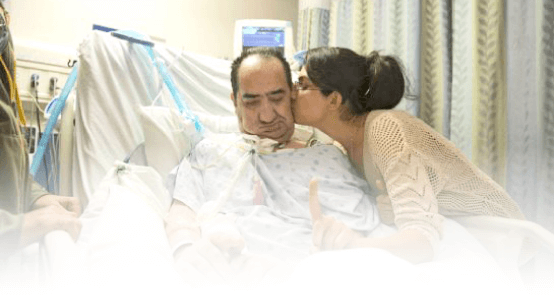Hi, it’s Patrik Hutzel from INTENSIVECAREHOTLINE.COM where we instantly improve the lives for Families of critically ill Patients in Intensive Care, so that you can make informed decisions, have PEACE OF MIND, real power, real control and so that you can influence decision making fast, even if you’re not a doctor or a nurse in Intensive Care!
This is another episode of “YOUR QUESTIONS ANSWERED“ and in last week’s episode I answered another question from our readers and the question was
How Can I Bring My Sister Home Who is on a Ventilator in ICU?
You can check out last week’s question by clicking on the link here.
My Sister in ICU is for Abdominal Surgery Due to an Infected PEG (Percutaneous Endoscopic Gastrostomy) site! Help!
In this episode of “YOUR QUESTIONS ANSWERED” I want to answer a question from one of my clients Joyce as part of my 1:1 consulting and advocacy service! Joyce’s sister is in ICU with tracheostomy on a ventilator and Joyce is asking for help because her sister will undergo an abdominal surgery due to an infected PEG site.
My Sister in ICU is for Abdominal Surgery Due to an Infected PEG (Percutaneous Endoscopic Gastrostomy) site! Help!

“You can also check out previous 1:1 consulting and advocacy sessions with me and Joyce here.”
Patrik: No, no, no. She’s too unsteady to go to LTAC. If she needs 100% of oxygen, she’s too unstable. Too unstable.
Joyce: Right. Okay.
Patrik: They wouldn’t have a clue in LTAC how to deal with 100% of oxygen. No way.
Joyce: Okay. And because they move her and she still desaturates, that’s unstable.
Patrik: Very much so. Very much so.
Joyce: And then that’s a good piece of information.
Patrik: I don’t think that LTAC is on the cards at the moment.
Joyce: I don’t either. But now I got to get a step ahead of them, because I don’t trust them. You saw what they just did.
RECOMMENDED:
Joyce: Let me give you the whole rundown, we’re still doing this. Well, she’s having a problem with the PEG. The problem with the PEG was, they had to take it out. They took out the PEG. They kind of were waiting for the incision to get closed so they can do a new one and that’s what got us to buy more time at the hospital. Currently, she’s at a five PEEP and
Patrik: Sorry, five PEEP and
Joyce: 40.
Patrik: 40 FI02?
Joyce: Yes, do not quote me on this, but I believe that PEEP is 33, I think.
Patrik: Hang on, let me just make some notes.
Joyce: I just called the nurse before, the blood gas which was done on the 20th, showed that it was 79 and the carbon dioxide was 38.
Patrik: I assume the 79 is PO2.
Joyce: She said oxygen. She goes, “There’s a lot of numbers, which one? “I said, “Give me the oxygen one.
Patrik: Okay, there is someone waiting, Jane, is she for this call?
Joyce: Yeah, that’s my sister, bring her in.
Patrik: Okay, just give me a second.
Joyce: She’s just going to be a listener.
Patrik: Should be here.
Joyce: Connecting to auto. Well, she’s connected just to auto, I guess. There she is, okay.
Patrik: Hi, Jane. That looks good. Looks good on what you’re telling me just on numbers.
Joyce: Okay, and then basically I saw the doctor, I actually caught him on FaceTime, very hard person to get a hold of. I said, “Are you doing the breathing trial?” He said, “I don’t want to rush it quite yet because of the carbon dioxide.” He did ask the respiratory therapist today, but she was a little bit unstable so the respiratory therapist said, “Not today.” But I’ve been on the doctor saying let’s do a breathing trial now. There was a respiratory therapist there the other day. I said, “Can you show me what it looks like?” He’s like, “Hold on.” He turned off the machine, five seconds, he said, “Look, your sister’s breathing on her own, he turned it back on, obviously, just to kind of-
Patrik: Five seconds.
Recommended:
Joyce: It wasn’t a true one. He just wanted to show me how it was. He wasn’t going into a full breathing trial with me on the phone, he was just trying to show me how it would work. It was just his courtesy of like just kind of training me of these settings. Okay, so that’s where we are with ventilators. We’ll get back to that, I have a bigger issue to fry. Right now, they called me yesterday. She had a procedure, tried to try to clip the problem, the hole in the stomach is not closing. They went yesterday to go through the tube to try to clip. The stomach, from the PEG, it’s not closing.
Patrik: So there’s a leak.
Joyce: There’s a leak, yes. So now they went in yesterday to try to clip the stomach. I didn’t hear from anybody at all, all day. And then finally I have a surgeon calling me today and say, we are not able to clip the stomach. We were not successfully clipping it. We want to do surgery and now it’s an abdominal surgery, so she would be cut open. They want to surgically close the hole in the stomach. They will be cleaning the incision, they’ll be cleaning it because it’s really infected. So they’ll be cleaning it, putting a tube out to drain out the infection and obviously, closing it from exterior. But the problem is the stomach has a huge hole and they cannot close it. And without-
Patrik: Internal hole.
Joyce: Yes, an internal hole in the stomach because the internal hole of the stomach is not closing. And they were thinking it would close on itself. And then they tried to clip it thinking, “Okay, let’s clip it.” And it’s not being clipped. So what they’re doing tomorrow is they want to, and I haven’t approved the surgery. That’s why I wanted to talk to you. They want to cut her stomach open, major surgery, stitch the stomach, clean the incision, and let that heal. They want to put a small tube through the intestines. Put the tube in the intestines, to feed her that way.
Patrik: Oh, a PEJ tube.
Joyce: To feed her temporarily because she needs nutrition. She’s been getting sugar for how long. So it’s a temporary situation until the whole stomach thing heals up and eventually go back to the PEG. But he said the area is so infected and we could not do another hole somewhere else because it’s so big.
Patrik: Oh my goodness. How do they know about the size of the hole will have they done a CT scan?
Joyce: Yesterday, they actually physically went in there to clip it.
Patrik: With the camera.
Joyce: I’m sure. Because they didn’t know how big it was until yesterday, they could not clip it. It was too big for them to clip. Now, I don’t think they’re lying to me. I mean..
Patrik: No, I don’t think so either.
Recommended:
Joyce: I mean, it’s like, it’s screwed up now. So obviously, this thing is temporarily because, obviously, from what I asked the surgeon, he said, “It’s a small tube, it gets clogged. It’s not a permanent situation, it can probably another month to two more, I don’t know how long basically for it to clog up, until the stomach heals and we can eventually put the PEG, if she still needs the PEG. Because the PEG is obviously what we need, but we can’t this time.
Patrik: Right, so basically what they’re asking for is surgery. And have they mentioned to you the term PEJ? P-E-J.
Joyce: P-E-J? No, what is that? No, they have not.
Patrik: Well, you’ve PEG take percutaneous endoscopic gastrostomy and PEJ stands for percutaneous endoscopic jejunostomy. It just means it’s a different location, but that’s what often happens. So they want to feed her into her intestines, and it’s sitting in the jejunum which is a part of the bowels. Ask them whether they’re talking about a PEJ, P-E-J.
Joyce: No, he explained it to me. He said, basically, we’re going to put it in the intestines where it’s feeding her through the intestines.
Patrik: Yeah, it’s probably a PEJ.
Joyce: I don’t remember hearing that word. But he was saying to me, we are stitching up the stomach. Underneath the incision, there’s a pocket that’s been filling up with lots of fluid of infection, so pus. So they’re afraid it’s going to create a drainage or that particular thing and stitch up the thing. He goes, “If this was healing and I could have clipped it, I would have just used the other side of the stomach. And I want to put another PEG in, but it’s not an option because I guess the hole is too big.” So now that’s where we are now. Now this is kind of where our exit game is, I don’t know how long. We’ve been in the hospital for 55 days.
Patrik: Just remind me Joyce, they did the PEG at the same time they did the tracheostomy, same, same time.
Joyce: No, they did not. They waited a week. They waited a couple of days, like four days later. I was kind of pissed, I’m like, “They did not do it at the same time.” They couldn’t get a surgeon or whatever. So it was done probably a week later, or four days later or five days later.
Joyce: And the only reason they didn’t transfer her because we had another like family friend that’s exactly in my sister’s situation and exactly in the same hospital, and the minute she got the PEG done, she’s already in another place. My sister stayed there because something was maybe off, or something wasn’t good or I don’t know. But-
Jane: The PEG got infected.
Joyce: The PEG got infected.
Patrik: So the last time I heard from you was on Monday. I’m just looking through my messages. So has-
Joyce: Let me also give you an update for his thing. The CT came out good. The EEG came out low response, MRI, my mom did not want to put her through because she just said she actually started being a lot more conscious. I know our Glasgow last time we spoke, but she started being a lot more conscious, get this-
Suggested links:
Jane: My mom went to visit her and he told-
Joyce: And then basically they actually let my mom have a visitation. We fought for visitation, she got in there. And she was totally alert, totally looking on her. Normally, we get them for like a half an hour, 40 minutes. She was for four hours, while she was there, 100%-
Patrik: That’s great.
Joyce: Moving her head, beaming her eyes. It was crazy, it was like, “Oh my God.” My mom said, “I feel her, I feel her.” It was like insane. I can even log in really quickly just to see-
Recommended links:
Patrik: That’s great, that’s really good news. So the waiting, you think, has paid off.
Jane: The camera is off.
Joyce: The camera is off. Somebody turned it off, you can’t reconnect it. Can you try to reconnect it so we can show Patrik just what she looks like? My sister’s-
Jane: I don’t know if I’ll be able to do it.
Joyce: Just try. Anyways, I still have the 24 hour monitoring. Look, they know we mean business. We are all hands on deck. We see her every hours of the day we talked to her news, sports. My mom touched her, it was fantastic. The nurse the other day said she responded her name and squeezed. Everyone else has said she hasn’t been responsive, but Patrik, you can see her eyes are like this, moving. She’s not mouthing, but I’m getting a feeling that somebody is there. And I guess this is all we can go, is on feeling.
Patrik: Yeah, intuition.
Suggested links:
Joyce: Intuition, we’re like, okay, this is my mom who’s been with her for longer years, sat next to her. And she looked her dead in the eye and she goes guys, she’s there. So I’m going to take it off that. I don’t trust anybody obviously. My question is, after this is done, can I make an argument saying, “I want to stay until she heals for the PEG.” Can I say that?
Patrik: You can say anything, Joyce. As you heard me say before, everything in life is negotiable. Have you heard from the health fund that they want to kick out your sister?
Joyce: Nobody talked to me at all. Nobody said anything to me. Nobody reached out to me at all. Anne, the lady who was taking care of her, which she has like 43 year experience. She’s a good doctor. She said she’s doing better, the lungs are not getting worse. She said, weeks to months.
Patrik: Okay, let me ask you this. So let’s just stick with this PEG for now because I think that’s one, and then we can go to the ventilator. My concern is very rarely do PEGs leak. Does it happen? Yes it does. But it only usually happens if a PEG doesn’t get changed after six months or something like that. So that’s definitely a concern. The other concern to me is, does she have an infection? Does she have a fever? Is her white cell count up? Have they told…
Joyce: She doesn’t have a fever but my question is, I don’t think they’re lying about it, so what do you think it is? Meaning was in a botch job, maybe?
Jane: Could’ve been.
Patrik: A new PEG shouldn’t cause that problem. And an older PEG that’s not getting changed, they should be changed every six months. If it hasn’t been changed after six months and it goes to eight months and something like this happens, well you haven’t changed it.
Joyce: Well, we had a problem right in the beginning.
Recommended:
Patrik: That’s the concern. My concern is, have they talked about a peritonitis? Do you know what I mean by that?
Joyce: No.
Patrik: So the risk, the risk for something like that is it could turn into peritonitis, which is an infection of the abdomen.
Joyce: Well, they said that to me, if I leave the hole open, that’s why they’re rushing to do surgery tomorrow morning. And that’s why I was like, when I feel rushed, even though I know it’s the best decision for my sister, I had to like seek out to you because I’m like… I have to just make sure that there’s a sound situation because they said, if we leave this open, she will get an infection, the longer it’s open. Because you just said you can wait, but the odds of, I’m sure what you said, will get infected. So my question is, I have no choice.
Patrik: It sounds like you have no choice. You should probably ask for things like does she have a fever? Is her white cell count elevated? You know what I mean by that, with fever white cell count?
Joyce: Yeah, 100%.
Patrik: Fever, white cell count.
Joyce: She hasn’t had a fever, I’ll tell you that. Fever-wise, I know she didn’t.
Patrik: Okay, and do you know if her vital signs are stable?
Joyce: She’s actually going right now, they just did a whole ultrasound on her heart. She has not been cleared for surgery quite yet. The surgeon said, “I am going today.” We’re waiting to clear her, which means they just did a whole heart thing to make sure that her doctor has to look over, to make sure she’s safe for surgery, or whatever else needs to be done. They won’t put them in surgery unless she’s safe enough to do it. And that’s what they’re working on today. I saw the lady like frantically working on an echo.
RECOMMENDED:
Patrik: Of course. What about issues like is she absorbing feeds, is she opening bowels? There’s no issue in the digest.
Joyce: Good question that you said that she has a rectum tube in even though I’m trying to get the rectum tube out, because I’m so pissed that it’s there. And it’s been there for a long time and I don’t know if they’re doing that because they don’t want to clean her, I’m trying to obviously stay on top of it. But they said the reason the rectum tube was there for so long it’s because she’s developing bedsores. So they’re saying we don’t want it to get more infected. So she has a rectum tube. Now, she’s not even making that much stool because she’s on sugar water or whatever they’re giving her. And today, she said that because of the procedure yesterday, she’s letting a lot of gas out from the surgery and they have to change the bag. No poop is coming out. I was kind of like being advocate about taking this tube out, but I don’t know.
Patrik: Look, if someone has diarrhea and if someone has pressure sores and stools get into the pressure sore, you would want the rectal tube but the rectal tube needs to be managed properly. They need to change it regularly because if they-
Joyce: Okay, so I think if we keep asking, they keep changing it.
Patrik: Absolutely, and I’ll tell you why. If the rectal tube is not getting changed regularly, that could cause trauma in the bowels potentially cause a perforation. So really look as-
Joyce: I’m going to ask them. I watch her all day long. I watch if she’s getting turned. I watch if the RT is there, I’m watching it and I’m literally with somebody every half an hour seeing some movement. But again, I will ask for it to be changed.
The 1:1 consulting session will continue in next week’s episode.
How can you become the best advocate for your critically ill loved one, make informed decisions, get peace of mind, control, power and influence quickly, whilst your loved one is critically ill in Intensive Care?
You get to that all important feeling of making informed decisions, get PEACE OF MIND, CONTROL, POWER AND INFLUENCE when you download your FREE “INSTANT IMPACT” report NOW by entering your email below!
In Your FREE “INSTANT IMPACT” report you’ll learn quickly how to make informed decisions, get PEACE OF MIND, real power and real control and how you can influence decision making fast, whilst your loved one is critically ill in Intensive Care! Your FREE “INSTANT IMPACT” Report gives you in-depth insight that you must know whilst your loved one is critically ill or is even dying in Intensive Care!
Sign up and download your FREE “INSTANT IMPACT” REPORT now by entering your email below! In your FREE “INSTANT IMPACT” REPORT you’ll learn how to speak the “secret” Intensive Care language so that the doctors and the nurses know straight away that you are an insider and that you know and understand what’s really happening in Intensive Care! In your FREE report you’ll also discover
- How to ask the doctors and the nurses the right questions
- Discover the many competing interests in Intensive Care and how your critically ill loved one’s treatment may depend on those competing interests
- How to Eliminate fear, frustration, stress, struggle and vulnerability even if your loved one is dying
- 5 mind blowing tips & strategies helping you to get on the right path to making informed decisions, get PEACE OF MIND, control, power and influence in your situation
- You’ll get real world examples that you can easily adapt to you and your critically ill loved one’s situation
- How to stop being intimidated by the Intensive Care team and how you will be seen as equals
- You’ll get crucial ‘behind the scenes’ insight so that you know and understand what is really happening in Intensive Care
- How you need to manage doctors and nurses in Intensive Care (it’s not what you think)
Thank you for tuning into this week’s YOUR QUESTIONS ANSWERED episode and I’ll see you again in another update next week!
Make sure you also check out our “blog” section for more tips and strategies or send me an email to [email protected] with your questions!
Also, have a look at our membership site INTENSIVECARESUPPORT.ORG for families of critically ill Patients in Intensive Care here.
Or you can call us! Find phone numbers on our contact tab.
Also check out our Ebook section where you get more Ebooks, Videos and Audio recordings and where you can also get 1:1 counselling/consulting with me via Skype, over the phone or via email by clicking on the products tab!
This is Patrik Hutzel from INTENSIVECAREHOTLINE.COM and I’ll see you again next week with another update!







